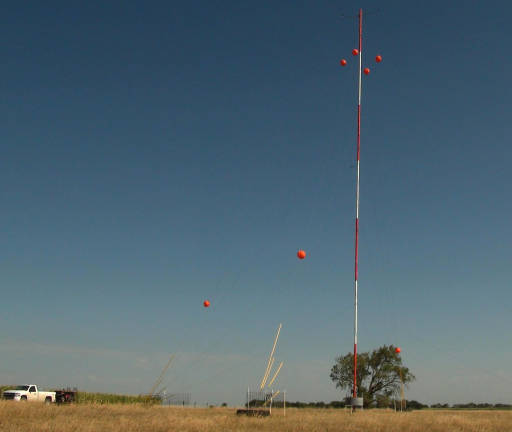
A UNL Extension educator is trying to make the skies a little safer for low-flying area pilots.
John Hay's goal is to encourage the wind-energy industry to properly mark its weather towers so pilots can see them. The Nebraska Aviation Trades Association, the professional organization of agricultural pilots in Nebraska, awarded a grant to UNL Extension to support Hay's work.
"This is the first grant that we have provided to UNL, and we are pleased that John Hay's project to encourage the wind energy industry to properly mark weather towers will save pilots' lives," said Brian Wilcox of Tilden, president of NATA.
The structures, called Meteorological Evaluation Towers, are built by the wind energy industry to collect wind data to determine whether a wind turbine farm is economically feasible.
As part of the tower marking awareness program, Hay has produced two YouTube videos.
"One video describes MET towers, their role in the wind energy industry and their risk to aviation. The second video demonstrates the equipment and procedure to mark a MET tower per FAA guidance," Hay said.
Both videos have recently been posted to YouTube (http://go.unl.edu/cwbioenergy) and are applicable to other states.
"We hope the videos will encourage owners of MET towers in Nebraska and other states to mark their towers to protect low-level aviation," Hay said. The two NATA/UNL MET tower marking videos are here.
The towers usually are built in one day and in place for one to two years. Typically, they are a slender column of galvanized metal, with guy wires in four directions. They are commonly built at a height of 194 to 199 feet, just short of the 200 feet requirement that requires lighting by the FAA.
The gray metal towers easily blend into the background, making them difficult for pilots to see and avoid, Hay said.
Hay expressed his appreciation for the support of the Nebraska Aviation Trades Association for its grant, which paid for purchase of materials and supplies for marking a tower, he added.
The FAA guidance to make the weather towers as visible as possible includes:
– Seven paint stripes of aviation orange and white (top to bottom)
– Eight spherical marker balls on guy wires (four within 15 feet of the top wire connection to the tower, and four at or below the midpoint of the structure on the outer guy wires)
– One high visibility sleeve on each guy wire anchor point plus a second sleeve on each outer guy wire
For Hay to obtain footage for the YouTube videos, Wilcox piloted his Air Tractor 502B aircraft over a field near a MET tower in northeast Nebraska this summer. Wilcox said he and his fellow pilots are constantly on the lookout for towers that too easily can take them out of the sky.
"Because the MET towers can be constructed in one day and are nearly invisible until too late to avoid in gray sky conditions, Hay's project is a matter of safety of flight," Wilcox said.
Wilcox reflected on the loss of his pilot colleague, Stephen Allen of Courtland, Calif., who died while applying seed by air when his airplane struck an unmarked weather tower last year.
"I encourage owners of MET towers to view Hay's YouTube videos and follow the FAA's marking guidance," Wilcox said.
Several types of low-altitude aviation benefit from weather tower markings and including life flight crews/patients, law enforcement surveillance, wildlife/game surveys, power line maintenance crews and aerial fire suppression.
In addition, towers in Nebraska that exceed a height of 50 feet and are outside the boundaries of any incorporated city or village are required by state law to be registered with the Nebraska Department of Aeronautics. Currently, there are about 90 meteorological evaluation towers registered in Nebraska. As a supplement to his project, Hay prepared a Nebraska map showing the location of each of them.